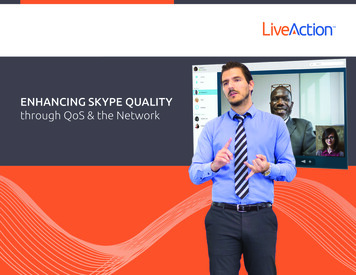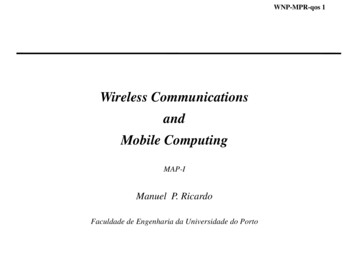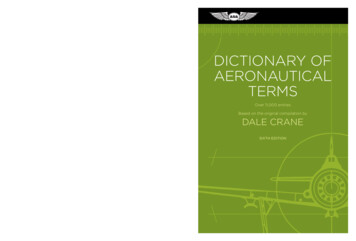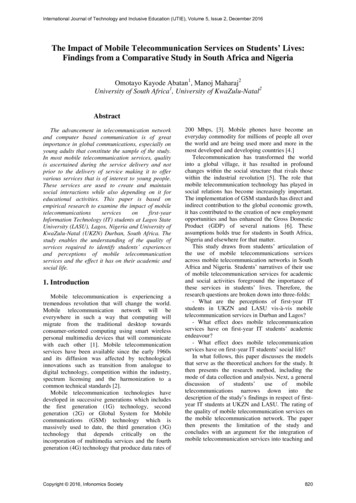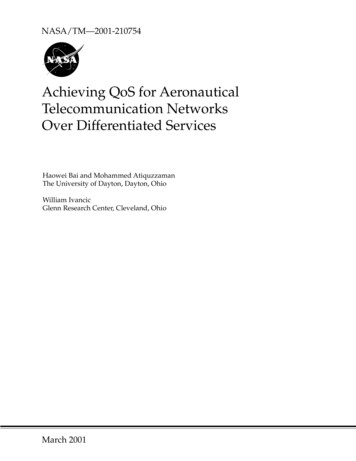
Transcription
NASA/TM—2001-210754Achieving QoS for AeronauticalTelecommunication NetworksOver Differentiated ServicesHaowei Bai and Mohammed AtiquzzamanThe University of Dayton, Dayton, OhioWilliam IvancicGlenn Research Center, Cleveland, OhioMarch 2001
The NASA STI Program Office . . . in ProfileSince its founding, NASA has been dedicated tothe advancement of aeronautics and spacescience. The NASA Scientific and TechnicalInformation (STI) Program Office plays a key partin helping NASA maintain this important role. CONFERENCE PUBLICATION. Collectedpapers from scientific and technicalconferences, symposia, seminars, or othermeetings sponsored or cosponsored byNASA.The NASA STI Program Office is operated byLangley Research Center, the Lead Center forNASA’s scientific and technical information. TheNASA STI Program Office provides access to theNASA STI Database, the largest collection ofaeronautical and space science STI in the world.The Program Office is also NASA’s institutionalmechanism for disseminating the results of itsresearch and development activities. These resultsare published by NASA in the NASA STI ReportSeries, which includes the following report types: SPECIAL PUBLICATION. Scientific,technical, or historical information fromNASA programs, projects, and missions,often concerned with subjects havingsubstantial public interest. TECHNICAL TRANSLATION. Englishlanguage translations of foreign scientificand technical material pertinent to NASA’smission. TECHNICAL PUBLICATION. Reports ofcompleted research or a major significantphase of research that present the results ofNASA programs and include extensive dataor theoretical analysis. Includes compilationsof significant scientific and technical data andinformation deemed to be of continuingreference value. NASA’s counterpart of peerreviewed formal professional papers buthas less stringent limitations on manuscriptlength and extent of graphic presentations.TECHNICAL MEMORANDUM. Scientificand technical findings that are preliminary orof specialized interest, e.g., quick releasereports, working papers, and bibliographiesthat contain minimal annotation. Does notcontain extensive analysis.CONTRACTOR REPORT. Scientific andtechnical findings by NASA-sponsoredcontractors and grantees.Specialized services that complement the STIProgram Office’s diverse offerings includecreating custom thesauri, building customizeddata bases, organizing and publishing researchresults . . . even providing videos.For more information about the NASA STIProgram Office, see the following: Access the NASA STI Program Home Pageat http://www.sti.nasa.gov E-mail your question via the Internet tohelp@sti.nasa.gov Fax your question to the NASA AccessHelp Desk at 301–621–0134 Telephone the NASA Access Help Desk at301–621–0390 Write to:NASA Access Help DeskNASA Center for AeroSpace Information7121 Standard DriveHanover, MD 21076
NASA/TM—2001-210754Achieving QoS for AeronauticalTelecommunication NetworksOver Differentiated ServicesHaowei Bai and Mohammed AtiquzzamanThe University of Dayton, Dayton, OhioWilliam IvancicGlenn Research Center, Cleveland, OhioNational Aeronautics andSpace AdministrationGlenn Research CenterMarch 2001
AcknowledgmentsThe authors thank NASA Glenn Research Center for support of this project. Faruque Ahamed carried outsome initial work on this project.Available fromNASA Center for Aerospace Information7121 Standard DriveHanover, MD 21076Price Code: A03National Technical Information Service5285 Port Royal RoadSpringfield, VA 22100Price Code: A03Available electronically at http://gltrs.grc.nasa.gov/GLTRS
National Aeronautics and Space AdministrationGlenn Research CenterOurNASA/TM—2001-2107541
NASA/TM—2001-2107542
NASA/TM—2001-2107543
NASA/TM—2001-2107544
NASA/TM—2001-2107545
IP PacketATN PacketNetwork LayerVersion FieldInternet HeaderLength IndicatorType of serviceVersion/Protocol IDLifetimeTotal LengthIdentification0DFSPMSTime to LiveE/RTypeMFFragment OffsetSegment LengthChecksumHeader checksumDestination AddressLength IndicatorSource AddressDestination AddressDestination addressSource AddressLength IndicatorProtocolOptions FieldData1110 100001-low0000-normalSource AddressData Unit Identifier0000Segment OffsetTotal ority
ManagementSNMP,COPSetc.Diffservconfiguration eData inClassify,meter,action,queueingQoS controlmessagesNASA/TM—2001-210754RoutingcoreQoS agent(optional,e.g. RSVP)7Classify, Data outmeter,action,queueing
33AF43Class 1Class 2Class 3Class 48
DS onATN Packets9DS Router
ATN Sources2 ATNSourceswithPriorityCode:0000 111003 ATNSourceswithPriorityCode:0000 011125 ATNSourceswithPriorityCode:0000 000055Mb,1msDSDSRouterRouter2Mb,b,2M ms0.1s0.1m2Mb, 0.1ms42M0.1mb,s2Mb, 0.1m2Msb, 0.1ms0s.1msb, 02M1m0.b,2MNASA/TM—2001-2107541ATN Sinks91245910
NASA/TM—2001-21075411
NASA/TM—2001-21075412
NASA/TM—2001-21075413
00100.0000
NASA/TM—2001-21075415
0000100.0000
NASA/TM—2001-21075417
NASA/TM—2001-21075418
Form ApprovedOMB No. 0704-0188REPORT DOCUMENTATION PAGEPublic reporting burden for this collection of information is estimated to average 1 hour per response, including the time for reviewing instructions, searching existing data sources,gathering and maintaining the data needed, and completing and reviewing the collection of information. Send comments regarding this burden estimate or any other aspect of thiscollection of information, including suggestions for reducing this burden, to Washington Headquarters Services, Directorate for Information Operations and Reports, 1215 JeffersonDavis Highway, Suite 1204, Arlington, VA 22202-4302, and to the Office of Management and Budget, Paperwork Reduction Project (0704-0188), Washington, DC 20503.1. AGENCY USE ONLY (Leave blank)2. REPORT DATE3. REPORT TYPE AND DATES COVEREDTechnical MemorandumMarch 20014. TITLE AND SUBTITLE5. FUNDING NUMBERSAchieving QoS for Aeronautical TelecommunicationNetworks Over Differentiated ServicesWU–322–20–2A–006. AUTHOR(S)Haowei Bai, Mohammed Atiquzzaman, and William Ivancic7. PERFORMING ORGANIZATION NAME(S) AND ADDRESS(ES)8. PERFORMING ORGANIZATIONREPORT NUMBERNational Aeronautics and Space AdministrationJohn H. Glenn Research Center at Lewis FieldCleveland, Ohio 44135 – 3191E–126849. SPONSORING/MONITORING AGENCY NAME(S) AND ADDRESS(ES)10. SPONSORING/MONITORINGAGENCY REPORT NUMBERNational Aeronautics and Space AdministrationWashington, DC 20546– 0001NASA TM—2001-21075411. SUPPLEMENTARY NOTESHaowei Bai and Mohammed Atiquzzaman, Department of Electrical and Computer Engineering, The University ofDayton, Dayton, Ohio 45469–0226 (work funded by NASA Grant NAG3–2318); and William Ivancic, NASA GlennResearch Center. Responsible person, William D. Ivancic, organization code 5610, 216–433–3494.12a. DISTRIBUTION/AVAILABILITY STATEMENTUnclassified - UnlimitedSubject Category: 1712b. DISTRIBUTION CODEDistribution: NonstandardAvailable electronically at http://gltrs.grc.nasa.gov/GLTRSThis publication is available from the NASA Center for AeroSpace Information, 301–621–0390.13. ABSTRACT (Maximum 200 words)Aeronautical Telecommunication Network (ATN) has been developed by the International Civil Aviation Organization tointegrate Air-Ground and Ground-Ground data communication for aeronautical applications into a single network servingAir Traffic Control and Aeronautical Operational Communications. To carry time critical information required foraeronautical applications, ATN provides different Quality of Services (QoS) to applications. ATN has therefore, beendesigned as a standalone network which implies building an expensive separate network for ATN. However, the cost ofoperating ATN can be reduced if it can be run over a public network such as the Internet. Although the current Internetdoes not provide QoS, the next generation Internet is expected to provide QoS to applications. The objective of thispaper is to investigate the possibility of providing QoS to ATN applications when it is run over the next generationInternet. Differentiated Services (DiffServ), one of the protocols proposed for the next generation Internet, will allownetwork service providers to offer different QoS to customers. Our results show that it is possible to provide QoS to ATNapplications when they run over a DiffServ backbone.14. SUBJECT TERMS15. NUMBER OF PAGES24Protocol; Internet16. PRICE CODEA0317. SECURITY CLASSIFICATIONOF REPORTUnclassifiedNSN 7540-01-280-550018. SECURITY CLASSIFICATIONOF THIS PAGEUnclassified19. SECURITY CLASSIFICATIONOF ABSTRACT20. LIMITATION OF ABSTRACTUnclassifiedStandard Form 298 (Rev. 2-89)Prescribed by ANSI Std. Z39-18298-102
Time to Live Protocol Header checksum Source Address Destination address Options Field Data Priority . action, queueing Routing core Egress interface Classify, meter, action, queueing Data out QoS agent (optional, QoS control e.g. RSVP) messages NASA/TM—2001-210754 7. AF11 AF12 AF13 AF21 AF22 AF23 AF31 .
